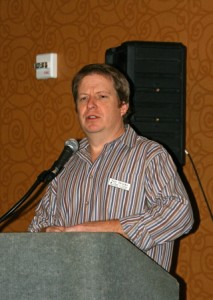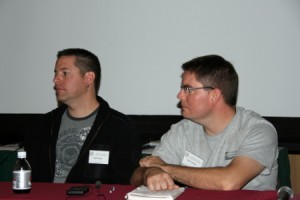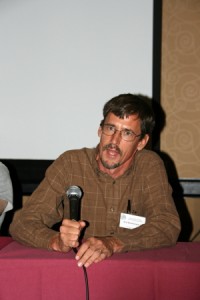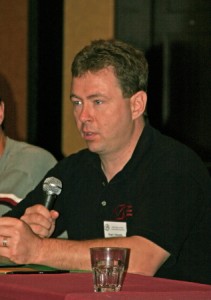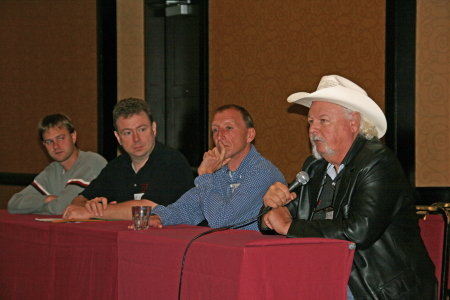Roger Edwards is a great guy–a Dallas Cowboy fan, family man, writer, photographer, and down-to-earth Renaissance man. He’s also a name anyone involved in storm chasing is either quite familiar with or else ought to be. When the man talks about severe weather, his words pack the clout of not only a veteran chaser, but also one of today’s foremost authorities on his subject.
With his wife, Elke, Roger maintains an engaging online presence in their blogs Stormeyes and Weather or Not, as well as in the scholarly Electronic Journal of Severe Storms Meteorology. Besides being a prominent weather scientist and forecasting expert, Roger is also a deep thinker and a superb writer whose passion for the world around him colors his words. I’m delighted and honored to feature him as my guest. Given free rein to expound on whatever topic was hot upon him, Roger took a direction I didn’t expect. His message is a timely one that speaks not only to all those of us who, like Roger, “feast on the smorgasbord of atmospheric violence,” but also to everyone–and “everyone” here means everyone–who is impacted by services of our government that are essential to public safety and health.
There, Roger–how’s that for an introduction? Now I’ll shut up and let you take the microphone.
Protection of Life and Property: The Necessary Government Role
By Roger Edwards
I am writing not as a government employee tasked with protection of life and property through severe storm forecasts. Nor am I writing as a member of an employees’ union that is publicizing the most draconian possibilities, as whispered to them by an inner sanctum of upper management (who, unlike the union, can’t legally lobby).
Instead, I type on my own behalf as a taxpayer and private citizen who just happens to be intimately familiar on a personal level with the front-line impacts of some asinine and infantile political posturing that’s happening right now in Washington, DC.
Disagreement on how to finish paying for the rest of this fiscal year threatens either a shutdown of “non-essentials” or a budget that slices the daylights out of many that are both essential and not. “Essential” means law enforcement, military, utilities, storm forecasting, air-traffic control, prisons, border patrol, and other such activities that directly affect public safety and that aren’t necessarily 9-to-5 day jobs. Essential employees are not paid during a shutdown, but are required to report to work as “emergency” personnel. I am included in that, as part of a 24/7/365 storm-forecasting group.
The most extreme budget scenarios for the rest of fiscal 2011 (through October) could result in rolling closure of both warning offices and national forecasting centers, along with unpaid furloughs lasting weeks at a time. That would be insane, headed into both peak tornado and hurricane seasons. What a crappy, backhanded “reward” for the dedication and effort that severe weather and hurricane forecasters devote every day and night…all day, all night. (Don’t worry, I never would resort to faking illness like those lying liars in Wisconsin…I actually am honest, and care too much about my duty!)
Politicians of both parties, in their zeal (and however noble the principles) are ignorantly unaware of the truth that not all government is equally useful, and that the most valuable and necessary government functions are those that protect life and property…period! In any democratic (lower-case “d”) system, all else is secondary to public safety as a responsibility of a government.
Here’s the ugly reality: Those life-saving functions that mean the most are typically small and focused, scattered and buried throughout numerous much bigger agencies full of bloat. In the tangled mess of government bureaucracy, the needed is interwoven with the unneeded, the important with the optional, the efficient with the wasteful–sometimes very tightly! You can argue that it’s partly by design, in order to use the lifesaving functions as human shields against elimination of the wasteful rubbish. I’ll fully grant that it could be a valid argument and a tactic used by some politicians to protect sacred pork.
But it’s still reality. To remove the unnecessary areas in shrinking big government is a good thing, done very selectively. But most elected officials don’t understand this and try to engage in shortsighted slashing that throws babies out with bathwater.
Meanwhile, as in the current standoff over a looming “shutdown,” those government employees engaged in protection of life and property are used as pawns for show. It’s a dirty, rotten, slimy game of political brinkmanship brought about by the shortsighted spending practices of Congresses and administrations of both parties, past and present.
Such childish foolishness, purely for the sake of posturing, cuts the meat and bone under the fat. It’s happened before, it’s nothing new, and it’s ridiculous. The strategy: Threaten to cut the visible, necessary stuff–like storm forecasting, air-traffic control, meat inspection, border security, law enforcement, anti-terror and such–to cover for fiscal irresponsibility on the unnecessary rubbish. It is a time-honed ploy, definitely bad for the country, and speaks to the immaturity and ignorance of politicians in general.
Does fiscal austerity need to happen? Absolutely! Liberals as a whole, and fiscally liberal Republicans, cannot bury their heads in the sand anymore and ignore the national debt. Think of the less-than-worst scenarios that may result as short-term pain for long-term gain.
Public debt is out of control. That’s an overwhelming national consensus. We all need to make sacrifices to cover for past and current fiscal irresponsibility by politicians of all parties. I support smart, targeted cutting of government, starting with the fat.
Notice that I have not complained about the salary freeze, which includes my own. It’s only fair that all government employees sacrifice some. If I now can’t buy a new violin for my daughter in orchestra because the family budget needs to be tightened, because it’s better for the country…it’s unfortunate, but that’s life. Others are far worse off!
Answer this, however: Do politicians have a history of smart, targeted streamlining of swollen government? Do politicians have a track record of taking intelligent, careful time and consideration, or do they instead resort to short-fused, publicity-grabbing, slash-and-burn, one-size-fits-all grandstanding?
To answer that, watch the news and read the stories today, where Democrats blame Republicans, Republicans are blaming Democrats and each other, and back-and-forth grandstanding commands the press. Then think back to past government “shutdowns” such as that at the end of 1995 and early 1996, or 1990 (each of which happened since I’ve been involved). Republicans or Democrats in the Presidency, Republicans or Democrats in Congress, none are blameless in the sort of showboating and lack of foresight that allows the federal budget sickness to get this far.
I’m here to tell you that life-saving functions must not be chopped. That includes storm forecasting.
Consider both sides of this coin.


Five cents. This gleaming little Jefferson is about how much NOAA (which includes the National Weather Service) costs each of us taxpayers each day. Some of that involves all the people and machines that enable forecasts of both dangerous and calm weather. Some of NOAA admittedly involves top-heavy layers of management and bureaucracy above the front-line workers. Much of those are glad-handing, paper-pushing, suit-and-tie roles that I see as not absolutely necessary, and that could and should be trimmed. Yet when those very bureaucrats are ordered to make recommendations for cuts, do you think they will be targeting their own jobs? If you do, I’ve got land about a hundred miles south of New Orleans to sell you.
Life-saving nickels are being swept off the pavement right in front of an out-of-control dump truck overflowing with borrowed zillion-dollar bills, representing entitlements and other giant-scale spending that needs to be braked first. Politicians generally don’t have the courage to do that, nor the understanding to thoughtfully focus merit-based cuts elsewhere. The chopping devolves into a blind, mindless, one-size-fits-all exercise; hence, we must take the bad with the good, the inefficient with the necessary, hoping someone with patience and courage eventually conducts a long, careful, well-informed, and elaborate trim inside each bureaucracy with a very fine and efficient surgical knife.
Ask yourself something more: Are national and local severe storm outlooks, tornado watches and warnings, hurricane watches and warnings, winter storm watches and warnings, and every other daily forecast, worth five cents? You decide. And if you say yes, tell your elected officials in no uncertain terms.
===== Roger Edwards =====
American taxpayer and
severe weather scientist
